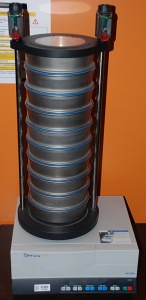Análisis granulométrico (UNE-EN 15149-1, UNE-EN 15149-2)
Contacto: Antonio Soria
El conocimiento de la distribución de tamaños del combustible sólido es necesario para la selección del proceso de transformación termoquímica óptimo en cada caso. Con este fin se realiza el análisis granulométrico de la muestra por medio de una tamizadora automática y una serie de tamices de distintas aberturas.
Normativa aplicable
-
UNE-EN 15149-1 Determinación de la distribución de tamaño de partícula. Parte 1: Método del tamiz oscilante con abertura de malla igual o superior a 1 mm.
-
UNE-EN 15149-2 Determinación de la distribución de tamaño de partícula. Parte 2: Método del tamiz oscilante con abertura de malla inferior o igual a 3,15 mm.

Tamizadora

Tamices
Tamizadora Retsch AS 200. Se trata de una tamizadora automática en la que se pueden emplear tamices con diferentes aberturas, pudiendo controlarse tanto el tiempo de tamizado como la amplitud de la vibración durante el proceso.
Tamices. El número de tamices y el tamaño de su abertura puede ser seleccionado por el cliente.
-
Balanza capaz de medir la masa del tamiz más la muestra con una precisión de 0,01 g.

Balanza
-
La masa mínima de la muestra analizada es 50 g.
-
La masa de muestra analizada puede aumentarse sin exceder en ningún caso una altura de la capa de muestra en un tamiz dado de 2 cm.
-
La muestra ha de contar con un contenido en humedad inferior al 20%. En caso de superar dicho contenido en humedad se requiere realizar un proceso de presecado. En cualquier caso se requiere realizar el ensayo de determinación del contenido en humedad de la muestra.
-

Muestra en el tamiz superior
Se montan sobre la tamizadora los tamices seleccionados por el cliente en orden decreciente de tamaño de abertura, terminando en un recogedor.
-
Se pesa la muestra a analizar con una precisión de 0,01 g.
-
Se esparce la muestra de forma homogénea sobre el tamiz superior y se comienza el proceso de cribado.
-
El proceso de cribado continúa hasta que la variación de la masa entre dos tamices consecutivos no supere el 0,3% durante 1 min o se selecciona un tiempo de cribado fijo igual a 30 min.
-
Se pesa el material neto retenido en cada tamiz y en el recogedor con una precisión de 0,01 g.
Resultados del ensayo
-
Masa total de muestra ensayada.
-
Contenido en humedad de la muestra, en base al ensayo de determinación de humedad.
-
Porcentaje de masa total retenido en cada tamiz.
Contact: Antonio Soria
The determination of the size distribution of a solid fuel is necessary to select an optimal thermo-chemical conversion process. The sieving analysis of the sample will be carried out with a test sieve shaker, employing sieves with different apertures.
European Standard
-
EN 15149-1 Solid biofuels – Determination of particle size distribution – Part 1: Oscillating screen method using sieve apertures of 1 mm and above
-
EN 15149-2 Solid biofuels – Determination of particle size distribution – Part 2: Vibrating screen method using sieve apertures of 3,15 mm and below.

Sieve shaker

Sieves
-
Sieve shaker Retsch AS 200. It is an automatic sieve shaker capable of employing several sieves with different apertures, comtrolling both the shaking time and the amplitude of the vibration during the process.
-
Sieves. The number of sieves and the size of their apertures can be chosen by the customer.
-
Scale capable of weighing the sieve and the sample with an accuracy of 0.01 g.

Scale
-
The minimum size of the sample is 50 g.
-
The mass of the sample can be higher, but never exceeding a height of 2 cm of sample layer over the upper sieve.
-
The moisture content of the sample must be lower than 20%. If the moisture content of the sample is higher than 20% a pre-drying process must be carried out prior to the sieving analysis. In any case, the moisture content of the sample must be also determined.
-

Sample over the upper sieve
The sieves are assembled on the test sieve shaker.
-
The sample is weighed with an accuracy of 0.01 g.
-
The sample is homogeneously distributed over the upper sieve and the sieving process starts.
-
The sieving process continues until the variation of the mass of the sample in two consecutive sieves is lower than 0.3% during 1 min, or a fixed sieving time of 30 min is utilized.
-
The net mass of the sample in each sieve is determined with an accuracy of 0.01 g.
Experimental results
-
Total mass of the sample tested.
-
Moisture content of the sample, based on the determination of the moisture content test.
-
Percentage of mass obtained in each sieve.